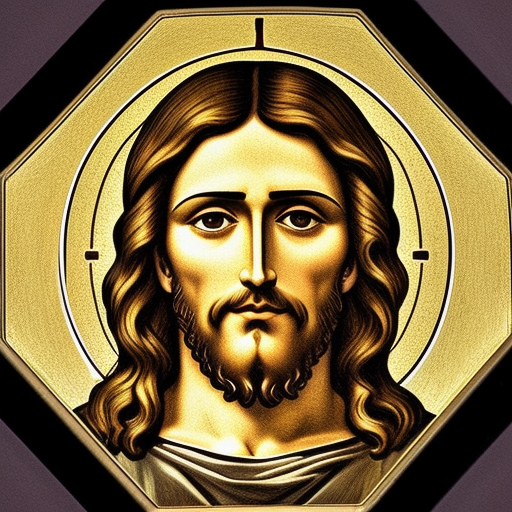Throughout history, Jesus Christ has been depicted in countless ways, with each image reflecting the time, place, and culture in which it was created. However, one of the most popular and enduring images of Jesus is the long-haired, gentle figure portrayed in countless paintings, sculptures, and other artistic representations. But what if I told you that this portrayal is inaccurate? This blog post will help you understand that Jesus, contrary to popular belief, did not have long hair. Using historical context, scripture, and academic sources, I will debunk the myth of Jesus’ long locks and shed light on the truth.
and enduring images of Jesus is the long-haired, gentle figure portrayed in countless paintings, sculptures, and other artistic representations. But what if I told you that this portrayal is inaccurate? This blog post will help you understand that Jesus, contrary to popular belief, did not have long hair. Using historical context, scripture, and academic sources, I will debunk the myth of Jesus’ long locks and shed light on the truth.
I. Cultural Context
To begin with, it is essential to consider the cultural context of Jesus’ time. Jesus was a Jewish man living in first-century Palestine, and it is important to understand the customs and practices of Jewish men during that era. Renowned pastors John MacArthur and R.C. Sproul have both addressed the topic of Jesus’ appearance in the context of first-century Jewish culture.
In his book “Twelve Ordinary Men,” MacArthur emphasizes that Jewish men of that time typically had short hair and beards, which suggests that Jesus and his disciples would have followed this norm. Similarly, in his teaching series “Dust to Glory,” Pastor Sproul notes that Jesus would have looked like an ordinary Jewish man of his time, including having short hair and a beard, in line with the cultural norms and expectations of first-century Jewish society.
According to historical records and depictions, Jewish men in the first century had short hair, as this was the prevailing style in the region. This would have made Jesus’ appearance consistent with the cultural norms of his time, confirming he did not have long hair.
By examining the cultural context of Jesus’ time and the teachings of pastors John MacArthur and R.C. Sproul, we can conclude that Jesus likely had short hair, consistent with the appearance of Jewish men in the first century. This understanding allows us to question and challenge the popularized depiction of Jesus with long hair, which is not supported by historical evidence or cultural practices.
II. Scripture
But let’s not rely on historical context alone. Scripture provides us with teachings that further bring to light Jesus did not have long hair. For instance, Paul writes in 1 Corinthians 11:14, “Does not the very nature of things teach you that if a man has long hair, it is a disgrace to him?” While Paul’s letters were written after Jesus’ time, they reflect the attitudes and beliefs of early Christians. If Jesus had long hair, it is unlikely that Paul would have made such a statement, as it would have been disrespectful to the very person Christians revered as their savior.
Moreover, in Numbers 6:5, the Nazirite vow, a voluntary religious commitment, is described: “All the days of the vow of his separation, there shall no razor come upon his head: until the days be fulfilled, in the which he separateth himself unto the Lord, he shall be holy, and shall let the locks of the hair of his head grow.” Some people argue that Jesus was a Nazirite because of his vow of separation from worldly things. However, there is no scriptural evidence to support this claim. In fact, Jesus is never explicitly described as a Nazirite in the Bible.
III. Artistic Representations
So, if Jesus didn’t have long hair, why do we see so many images of him with flowing locks? The answer lies in the evolution of artistic representations of Jesus. The earliest known images of Jesus, from the 3rd and 4th centuries, actually depict him with short, curly hair. It was only in the later Byzantine period, around the 6th century, that Jesus began to be portrayed with long hair.
This shift can be attributed to various factors, such as the influence of Greek and Roman artistic styles and the changing perceptions of Jesus as a divine figure. As Christianity spread throughout the Roman Empire, it absorbed many of the artistic styles and cultural norms of the time, including the depiction of gods and divine beings with long hair. This led to the gradual transformation of Jesus’ image from a short-haired Jewish man to a long-haired, ethereal figure reminiscent of Greek and Roman gods.
Another reason for the shift in Jesus’ appearance could be the changing theological understanding of his divine nature. As Christianity developed, the emphasis on Jesus’ humanity decreased, while his divinity became more central to the faith. By portraying Jesus with long hair, artists may have sought to emphasize his divine status, distancing him from the ordinary Jewish men of his time.
IV. The Shroud of Turin
Some proponents of the long-haired Jesus theory point to the Shroud of Turin as evidence. The Shroud, believed by some to be Jesus’ burial cloth, appears to show the image of a man with long hair. However, the authenticity of the Shroud has long been a subject of debate among historians, theologians, and scientists, with many arguing that it is a medieval forgery.
Moreover, even if the Shroud is genuine, it is important to remember that the image on it may not be an accurate representation of Jesus’ appearance. The Shroud is a burial cloth, and it is possible that the hair appears longer due to the way it was arranged during the burial process.
V. Women and Head Coverings in Scripture
Another aspect of this discussion worth mentioning is the issue of women and head coverings in scripture, which supports the understanding that Jesus did not have long hair. In the same passage where Paul discusses men’s hair length in 1 Corinthians 11, he also provides instructions regarding women’s head coverings. Specifically, he states in verses 5-6, “But every woman who prays or prophesies with her head uncovered dishonors her head—it is the same as having her head shaved. For if a woman does not cover her head, she might as well have her hair cut off; but if it is a disgrace for a woman to have her hair cut off or her head shaved, then she should cover her head.”
Paul’s instructions teach that women were expected to cover their heads during worship as a sign of submission and respect. It is important to note that Paul considers a woman’s long hair to be her “glory” (1 Corinthians 11:15), emphasizing the cultural difference in expectations regarding hair length between men and women in the early Christian community. If Jesus had long hair, it would have contradicted the gender norms and expectations of his time, as well as the teachings of his early followers.
The distinction between men’s short hair and women’s long hair, as expressed by Paul, may have served as a visual representation of the different roles and responsibilities of men and women within the early Christian community. This adds further weight that Jesus, as a Jewish man and a leader within this community, would have adhered to the prevailing norms of his time, which included having short hair.
By examining key scriptural evidence and historical context, we can gain a clearer understanding of Jesus’ true appearance and move beyond the popularized misconceptions that have persisted for centuries.
VI. Paul’s Authority and the Holy Spirit
In examining the issue of Jesus’ hair length and the cultural expectations of his time, it is important to consider the authority of the apostle Paul, who provides us with valuable insights into early Christian practices and beliefs. While some may question Paul‘s authority on this matter, it is crucial to recognize that he was an apostle called by God in the early Christian movement and his teachings are relevant until the return of Christ.
In 1 Corinthians 2:1-5, Paul emphasizes his humility and reliance on the Holy Spirit: “And so it was with me, brothers and sisters. When I came to you, I did not come with eloquence or human wisdom as I proclaimed to you the testimony about God. For I resolved to know nothing while I was with you except Jesus Christ and him crucified. I came to you in weakness with great fear and trembling. My message and my preaching were not with wise and persuasive words, but with a demonstration of the Spirit’s power, so that your faith might not rest on human wisdom, but on God’s power.”
Paul’s statement that he is “no one” but has the Holy Spirit reflects his understanding that his authority and knowledge come from God, not from his own accomplishments or wisdom. This assertion underscores the importance of Paul’s teachings, including those on hair length and head coverings, as they are informed by the Holy Spirit.
Paul’s reliance on the Holy Spirit demonstrates that the early Christian community was deeply connected to the teachings of Jesus, as they believed that the Holy Spirit was sent by Jesus to guide and instruct them (John 14:26). Therefore, it is wise to understand that the cultural norms and expectations regarding hair length that Paul outlines in his letters were consistent with the teachings and practices of Jesus himself.
The authority of the apostle Paul and his reliance on the Holy Spirit lends credibility to his teachings on hair length and head coverings, providing further evidence that Jesus did not have long hair. By acknowledging Paul’s connection to the Holy Spirit and the early Christian community’s commitment to Jesus’ teachings, we can gain a better understanding of the cultural norms and expectations of Jesus’ time, which ultimately support the argument that Jesus had short hair.
The primary motivation behind creating this blog post is teaching so the reader can have an understanding of what scripture instructs which is essential for spiritual growth and development. As stated in 2 Timothy 3:16-17, “All Scripture is God-breathed and is useful for teaching, rebuking, correcting and training in righteousness, so that the servant of God may be thoroughly equipped for every good work.”
By examining the historical context, scriptural evidence, and artistic representations of Jesus, this blog post seeks to correct misconceptions and encourage thoughtful reflection on Jesus’ true appearance.
Bonus: Does a pastor have a right to tell men/boys of his congregation they should have short hair?
Yes, a pastor does have the right to advise men and boys in his congregation to have short hair, provided that his guidance aligns with the teachings of the Bible and the historical context surrounding Jesus and early Christian practices. As spiritual leaders, pastors are responsible for shepherding their congregations and providing guidance on matters of faith and Christian living. They draw upon their understanding of scripture and historical context to provide instruction and direction to their flock.
By suggesting that men and boys maintain short hair, the pastor is not enforcing an arbitrary rule but rather encouraging adherence to the cultural norms and expectations of Jesus’ time and the early Christian community. And they should have a willing spirit to conform to what God asks of them through his Word. As discussed earlier in this blog post, short hair was the norm for Jewish men during Jesus’ time. 1 Corinthians 11:14 supports this idea. The pastor’s instruction is thus rooted in scriptural evidence and historical context.
It is important for men and women to respect, listen to, and follow the guidance of their pastor, who has been entrusted with the responsibility of their spiritual leadership. If individuals cannot or will not listen to the direction of their pastor, there is a critical issue that must be addressed. I am not talking about a wolf pastor in sheep’s clothing, we don’t and shouldn’t listen to them.
Here is what scripture says regarding men who are genuine and serious about being supervisors/leaders in the ecclesia:
- Hebrews 13:17 (ESV) – “Obey your leaders and submit to them, for they are keeping watch over your souls, as those who will have to give an account. Let them do this with joy and not with groaning, for that would be of no advantage to you.”CCD
This verse emphasizes the importance of obeying and submitting to spiritual leaders, as they have a responsibility to watch over the souls of the ecclesia.
- 1 Thessalonians 5:12-13 (ESV) – “We ask you, brothers, to respect those who labor among you and are over you in the Lord and admonish you, and to esteem them very highly in love because of their work. Be at peace among yourselves.”
Here, the scripture teaches to respect and hold in high regard those who serve as spiritual leaders and admonish the flock.
- Acts 20:28 (ESV) – “Pay careful attention to yourselves and to all the flock, in which the Holy Spirit has made you overseers, to care for the church of God, which he obtained with his own blood.”
In this verse, the responsibility of spiritual leaders is emphasized, as they are entrusted by the Holy Spirit to care for the church.
Now regarding what to do when someone refuses to listen to their pastor /deacon/elder, the Bible offers some guidance in the context of dealing with conflicts or disagreements within the church:
Matthew 18:15-17 (ESV) – “If your brother sins against you, go and tell him his fault, between you and him alone. If he listens to you, you have gained your brother. But if he does not listen, take one or two others along with you, that every charge may be established by the evidence of two or three witnesses. If he refuses to listen to them, tell it to the church. And if he refuses to listen even to the church, let him be to you as a Gentile and a tax collector.”
In this passage, Jesus outlines a process for resolving conflicts within the church, which can be applied to situations where someone is not listening to the direction of their pastor.
It is essential for the body of Christ to trust and follow their pastor’s guidance, as it is intended to help them grow spiritually and strengthen their relationship with God.
However, it is crucial to emphasize that the ultimate purpose of a pastor’s guidance is to bring the ecclesia closer to Jesus and his teachings. While the issue of hair length may seem minor, it serves as an example of how engaging with scripture and historical context can deepen our understanding of Jesus and allow us to live our lives more closely aligned with his example.
Idolatry?
In light of our discussion about Jesus’ physical appearance, it is also worth considering that it’s better not to have any images of him at all, be they pictures or sculptures. Call this my desire and step toward the role of supervision. Creating visual representations of Jesus can potentially lead to idolatry, as individuals may become fixated on these images overshadowing the fact that he has risen from the dead and is at the right hand of our heavenly Father interceding for all who believe in him. Let’s observe something, if someone burned a picture or statue you believe is the image of Jesus would you be ready to fight or be emotionally distraught as a result? If so why? He has risen. This is why we are to be mindful of where we hold things in our hearts and minds.
It is important to note that in this blog post, I use two images to illustrate my points. Each is not Jesus, but you might think they are. These images were employed to facilitate the discussion and emphasize the discrepancies between popular depictions of Jesus and historical context. My intention is not to promote any particular image but rather to foster a deeper understanding of Jesus and encourage readers to question their assumptions. By recognizing the potential pitfalls of relying on visual representations, we can steer clear of the idolatry trap.
Better to err on the side of caution than not
The belief that Jesus had long hair is not supported by historical context, scriptural evidence, or the evolution of artistic representations. Rather, it is a product of cultural and artistic influences that have shaped our perception of Jesus over time. By reexamining the evidence and questioning our assumptions/interpretations, we can gain a more accurate understanding of Jesus’ true appearance and separate myth from reality.
It is essential to remember that the true significance of Jesus encompasses his physical appearance, teachings, life, sacrificial death on the cross, resurrection as the living Son of God, and his continuing global impact. By debunking the myth of Jesus’ long hair, we shine light on erroneous teachings and go with what the Word says.



Leave A Comment